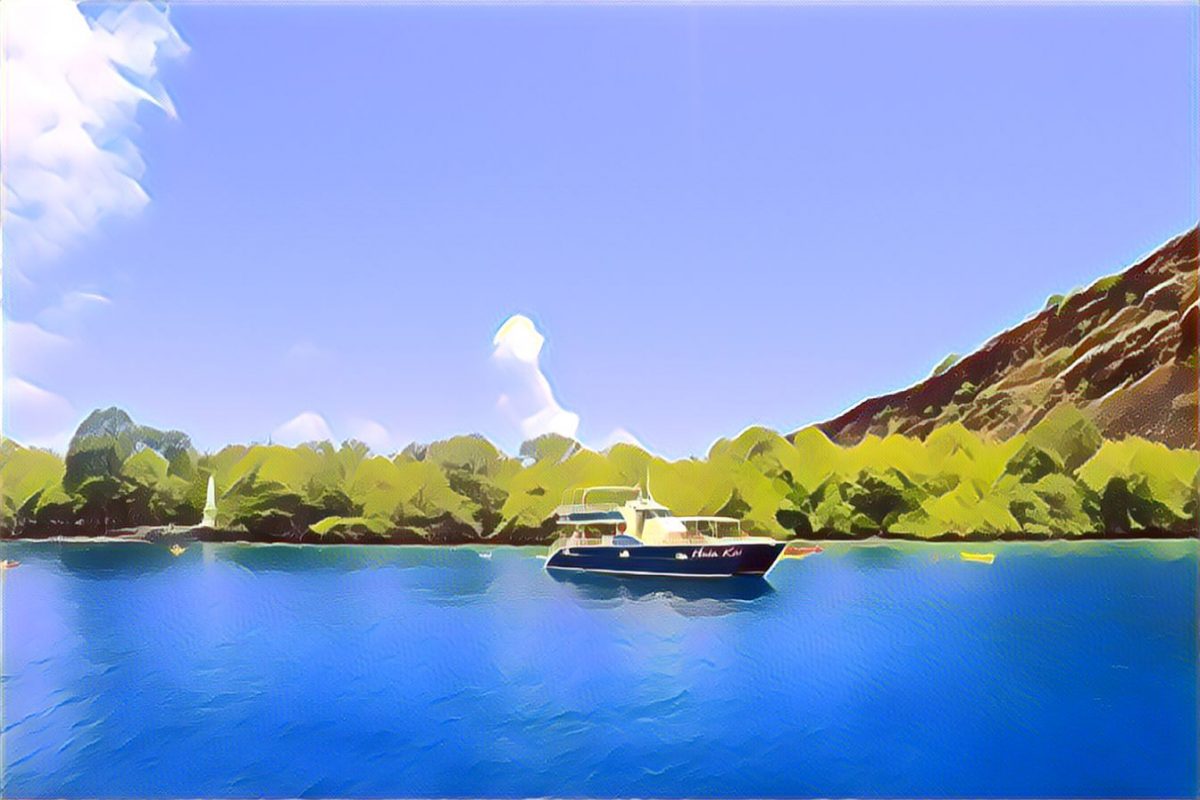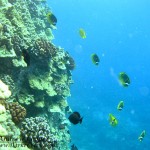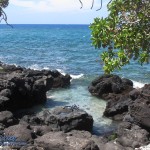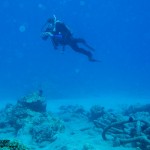
Tag: snorkel
Reef Critters Hawaii App
There are numerous guides to the reef life found around the Hawaiian Islands. Most are superficial, suitable for the casual tourist snorkeler at best. Short of delving into the professional level publications there are two sources I use all the time. The books by Hoover, one on fish and the other for the invertebrates, are my first stop when attempting to identify an animal. These well thumbed references are usually found on my desk beside the computer.

What about an app to do that?
To my pleasant surprise I have found that there is indeed an app. Combining information from John Hoover, Keoki Stender’s excellent photography, plus information from a few other contributors, you can now download everything to your phone for easy reference, even without a data connection.
Actually there are several apps in the series. As with Hoover’s books, fish and invertebrates are handled separately. You can get the phone version or the iPad oriented HS version.
This snorkelers guide to the most common invertebrates and other commonly seen water inhabitants in Hawai’i includes 374 gorgeous photos together with extensive notes for each. All content is by an experts in the field: Keoki and Yuko Stender, and snorkeling guidebook authors, Judy and Mel Malinowski. As a bonus, links to underwater videos by Keller Laros, Rob Whitton, Mel Malinowski and others are provided. – Description of Reef Critters Hawai’i
The apps are well organized and quick to use. As with any book, it helps to be able to recognize at least the family of fish or critter, this helps in navigating to the correct section. Scrolling though a list of species, each with a thumbnail image, allows quick choice of possible identifications.
It is unlikely that the apps will replace my use of the books… The listings are not as complete as the books or websites, many of the less common species are missing. There is generally only one photo per species, neglecting some color phases and juvenile stages. Still, a quick ID reference in the phone is quite convenient. There are a number of videos which I find fairly useless, I would gladly trade the memory requirements for a more complete species listing.
I have no trouble with the $4.99 cost of the apps, I consider it a contribution to the folks who have put together the great references I have used for many years of diving Hawaiian reefs.
Going Snorkeling
Normally I do not snorkel around the reef, rather I prefer donning full kit including tank and regulator allowing a more immersive experience. Staying down allows me a freedom of movement, to explore well beyond the twenty five feet or so that I can reach without the gear. Scuba permits me to carry a camera with time to compose a subject and observe behavior.

I skim along, the large fins providing effortless speed. The view is different than that of scuba, you are always looking down. I stay in the shallower water where the coral comes close to the surface. On occasion I dip down below the surface to get a closer look, weaving through the coral on long shallow dives. To go up I simply stop swimming to allow my buoyancy to lift me to the surface. A sharp breath clears the snorkel of water. With practice the actions are almost reflex, as natural as breathing on shore.
There are species that prefer the shallows, rarely seen when diving, often common in just a few feet of water. Snowflake morays, the colorful lagoon triggerfish, snorkeling allows spotting of a different reef community. I often make a point to sweep the areas just off the shore in three feet of water or less, just to see what can be found.
End-of-Road Puakō
Possibly one of the best dive sites in the islands and certainly a favorite with local divers. The reputation stems from two factors, great diving in interesting terrain and easy shore access. The diving here can range from acceptable to spectacular with stunning water clarity and spectacular views of the coral.
View Larger Map
Just north of the cove where you will enter, there is a series of deep canyons into the coral. These start near the surface in 6-10ft of water and descend to 25-30 ft. The result of the canyons are a range of vertical coral walls that reach from near the surface to depths of 20-40ft. At the head of several of the canyons are a series of arch caves and skylights to explore. You can just make out this cave on the Google map at right, just into the reef from the marker.
 A canyon wall at Puakō End-of-Road dive site with Yellow Tangs (Zebrasoma flavescens) and Raccoon Butterfly Fish (Chaetodon lunula)
A canyon wall at Puakō End-of-Road dive site with Yellow Tangs (Zebrasoma flavescens) and Raccoon Butterfly Fish (Chaetodon lunula)
In our favorite cave a large arch leads into a wide cavern with a skylight. A second arch leads to a smaller cavern, and so forth until they are too small to enter. Look into the side ledges and caves for squirrelfish and sleeping turtles. Much of the interesting diving is shallow allowing for long dives. If you want to go deeper just swim out further from shore as the reef continues to descend.
Reach this site by driving north from Kona on the Queen Ka’ahumanu Hwy to the Puakō turn off. Drive down the main road through town, mostly just homes along the beach, for about three miles to reach the end of the road. The beach access is on the right about 100yds before the road ends in a locked gate to a private estate. The parking area is easy to spot as it will be busy with other divers and locals enjoying the beach. There is a fair amount of space but this place can get busy later in the day, particularly on a weekend. Park under the trees just a few feet from the water, you should not have to carry your gear very far. The map at the right should give you the right idea.

The entry at End-of-Road, Puakō
Most divers enter from the rocks or use the slot into the rock at the north end of the cove. From here you need to swim to the center of the cove over shallow rock and coral (4-8ft) to go around a shallow bar that juts out from the north shore. Once over the bar bear to the north to find the canyons across coral at 10-15ft. A little swim, but very scenic snorkeling along the way.
Avoid use of the site if there is substantial surf across the bars at the north and south side of the cove. These create a stiff outwards current at the center of the cove that can be difficult to negotiate getting back to shore. Just look for the surfers! If they are happy and surfing nice waves, a diver will not be happy.
End-of-Road is a good dive site to consider if the more exposed sites further north or south are problematic with a large swell. The region from Waikoloa to Kawaihae is some of the most sheltered coastline on the island. We often head here during the winter for shore diving, leaving sites like O’oma or Mahukona for the calmer days.
Mahukona Harbor
Heading north from Kawaihae there is some of the best diving in the islands. Most of the sites along this rugged coast northern are best dived from a boat. You can reach many from shore, but access can be tricky and a matter of knowing which 4WD road will get you to a usable put in point. There are a couple exceptions where access is easy, the best is Mahukona.
What you find here is a small port from the days when sugarcane and cattle were transported on small steamships that plied the waters up and down the Hawaiian Islands. A substantial pier and other facilities were built in a small cove to serve the north end of the island. A railway terminated here, allowing products to be brought in from much of North Kohala. Most of that is gone now, replaced by good roads, semi trucks and the large port at Kawaihae. What is left is a sleepy little cove with perfect water and great diving.

A steel ladder at the top of the wharf provides access right into the water. The access is simply the easiest I have ever used on a shore dive. No sand, no slippery rock, simply a parking lot at the waters edge!
View Larger Map
Once you leave the pier head for the center of the harbor. You will quickly find several heavy mooring chains. Large and obvious these chains are heavily encrusted with coral, simply follow them out to the wreck of the Steamship Kauai. The wreck lies in 12-24 feet of water at the center of the harbor.
The engine and propeller are the largest parts to be found and are a little to the north of the large sandy area at the center of the cove. The propeller is in only about 12-15ft of water, accessible to snorkelers as well as divers. Connected to the propeller by the shaft is the large steam engine. This is less obvious when you first see it, but hard to miss once you know what it is. Closer inspection will show numerous pipes, control linkages and the large flywheel at the rear of the engine. Looking into the engine you can see the crankshaft and the numerous fish that find the engine a perfect hangout. Spend some time here, we have found a dwarf moray, blue dragon nudibranch and great fish at the engine.
Scattered out from the engine is a great deal of other evidence of the wreck. The steamship had a cargo of agricultural products and railroad parts when it sank. You will find quite a few wheel sets for narrow gauge rail car use, one is under the engine, others in the middle of the sandy area just seawards of the engine. Cables, piping and ballast bricks are everywhere. A boiler can be found on the north edge of the sandy area, about 4ft in diameter and 12ft long. Check inside to see who is home.
We found three different species of moray eels here, good fish and healthy coral. Not many large fish, fishing and spear hunting is allowed in the area. The small fish area very numerous with large numbers of fry int the shallows and around the wharf.
Mahukona is just about the perfect shore dive site. Park on the pier, and just drop your gear in the water. Shallow diving unless you head out of the cove, but a lot to see in the harbor, you may never make it any further. This site makes for a long shallow dive exploring a little local history.
Kohala Diving Guide
My March project is to move all of the dive guide articles over from the old blog. Most of them are already moved over, scheduled to post through this month. Copied and pasted over from the old blog, I have gone through them and updated the posts with current information. The series of blog articles provides a nice guide to anyone exploring the Kohala coast with the plan of getting in the water to snorkel and dive.
